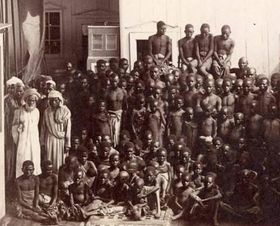Also see: Template:Pictorial-Islam
Slavery in Islam
|
|

|
|
Under Islamic laws, slavery is explicitly permitted. As Saudi Shaykh Saleh Al-Fawzan, a member of the Senior Council of Clerics had said in 2003, those who argue that slavery is abolished are "ignorant, not scholars. They are merely writers. Whoever says such things is an infidel." Prophet Muhammad himself was a slaver. He not only owned many male and female slaves, but he also sold, captured, and had sex with his slaves. Even his wives owned slaves. Muhammad's actions perpetuated the existence of this trade by institutionalizing it within Islam. This sanction of slavery has helped the Muslim world create one of the largest trans-continental slave trades in history. Slavery was officially abolished in the 1960's due largely to pressure from western nations, but the trade still exists in the Islamic world. As of July 2009, there were over half a million slaves in Mauritania alone. (read more)
|
|
|